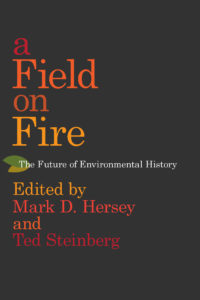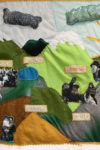
[University of Alabama Press; 2019]
During the legislative session, which runs from January to May most years, I work at the state legislature in Minnesota. During session the legislators will discuss a range of things that state legislatures tend to discuss, taxes and schools and workforce development, occasionally naming roads or parks after war heroes and politicians. There comes a day, most years (depending on what party controls which sections of government), in which the Democratic members in the House of Representatives will bring up a bill to formally recognize the human origin of global warming. These days contain quite a bit of debate. The bill never has funding attached, so there is no cost to the taxpayers. But, this is still never a quiet bill. In 2011, notably, a Republican member from outstate Minnesota brought up a pile of snow that remained in a nearby Sears parking lot to disprove the existence of global warming. “Maybe,” he suggested, noting the late snow fall, “we are headed for a global cooling.” 7 years later, he remains in office.
This year the debate dragged on for hours and hours, eventually grinding down into a stalemate. When the vote was finally taken it passed in a largely party-line vote, with all Democrats and 4 Republicans voting for it, and 50 republicans voting against it, with 5 abstaining. Despite passing. it will not become law; the Republican-controlled state senate will block it. In the year preceding this debate, 88 people died in the largest wildfires in California’s history, a freak summer hail storm caused over a billion dollars of damage in Texas, and Minnesota had one of the wettest and rainiest winters it’s ever had, leaving sheets of ice frozen on the streets of Minneapolis until April.
A Field on Fire: The Future of Environmental History is an academic essay collection that honors the memory of Donald Worster, an environmental historian who, by common agreement, seems to have done most of the work of inventing the field. Worster is a sympathetic figure, for an academic that never really climbed down from the ivory tower. The book immediately situates him as “not just another academic,” but someone who was inspired by Thoreau and thought that “moral reason must play a role in how an intellectual approaches the study of science,” who was “interested but never satisfied” by the “esoteric nuances of scholarly debates,” who was a kind of activist-academic.
After reading these introductory remarks, and keeping in mind the title of the book, one anticipates a series of essays seeking to rally and direct a discipline into an active future, one in which environmental history, as a discipline, responds to what is certainly the greatest environmental event since the industrial revolution, and potentially much larger. Just as the last 10 years have created celebrity economists like Thomas Piketty and Gabriel Zucman, it seems that the time for the politically-engaged environmental historian has arrived.
And yet, the essays largely saunter, contemplatively, around the edges of climate change, which is, indeed, rarely mentioned. Instead, the essays touch on a variety of other issues: methodological problems, arguments that the discipline must be comparative, that it should not blame capitalism, histories of places and things. One essay traces the importance of fiber production in the Philippines to the development of shipping and other industries in America; another argues, somewhat abstractly, that, since human being are in some way aerial in nature, that aerial-ity must be a focus of environmental history.
There are, puzzlingly, threads which point towards a more active and politically engaged approach. Almost all of the essays study some effect that industrialized society, whether modern agriculture or the American civil war or something else altogether, has wrought on the environment. The obvious central project of the discipline is, as other environmental disciplines have done, to draw a clear and convincing line between those practices that need to stop and the effects that they have so far created. The two exist in such close proximity that it often feels, going essay to essay, that one should be able push it into making the connection with a light shove. But even if one could do that, I think while reading, what good would this do at a place like the Minnesota Legislature?
The answer, depressingly, is “not much.” Academic modes of production, to use a term preferred by Worster outside of his preferred context, are shockingly ill-suited to a crisis, and certainly ill-suited to a crisis of this scale. They are unable to produce and deploy knowledge that is authoritative to wide swathes of the population, and few of the academics contributing to this book see that as their role.
This is, as this collection acknowledges, an epistemological difficulty, and admittedly not one that this particular discipline has been tasked with solving. Academia is an intrinsically elite discipline, and to critique this collection as being overly elite isn’t quite fair. For an academic collection, indeed, it is relatively readable, and there were several essays I read with attention and pleasure, including the aerial-ity piece. The problem arises when those feelings of attention and pleasure are overtaken by feelings of panic and despair, and this is a problem that gets worse by the day and shows no signs of reversing.
There is a little current of dissatisfaction that, outside the discipline, one feels while reading this collection. The title of the book is A Field on Fire, a blistering and violent image, and the collection, in places, mentions the “planetary crisis” that Worster dreaded even early on in his career. There is some duty to confront this crisis that the discipline has acknowledged, but decided not to meet. This does not place it outside the norm of academic knowledge-production, but the failure seems even more glaring here in the face of current events. The collection catalogues the past and imagines the future of a discipline. Worster, and most of us, imagine the future of a world, one which shows clear signs of disintegration. It is puzzling why these two things would not be linked in the collection, but they are not.
The most unintentionally summarizing anecdote in the book can be found in an essay about the inventor of chlorofluorocarbons, the refrigerants best known for poking holes in the ozone layer. The author describes the “oft-cited cautionary” tale of his death as bearing a lesson that “technology is subject to the law of unintended consequences.” After losing the use of his legs to polio, he developed a pulley system that allowed him to move from his bedroom to other regions of the house. Eventually, this system somehow turned against him, and, attempting to operate it in some way or another, he was strangled inside of it. Horribly, he died in his own home, with no one checking on him, his friends and family likely assured of the safety of his machine.
The lesson that “technology produces unforeseen consequences” is itself an abdication of the historian’s duty. History allows us foresight where we would not have it before. Having catalogued and studied all the strangling harnesses (and industrial modes of production) that came before, the harms that come from new versions of these are no longer unintended. They become foreseen, and the decision becomes one of accepting the damage they create or choosing to act differently. This book, while an engaging and readable academic text, does not attempt to accomplish that task.
Eamonn Gallagher is a writer living in Minneapolis, Minnesota.
This post may contain affiliate links.







